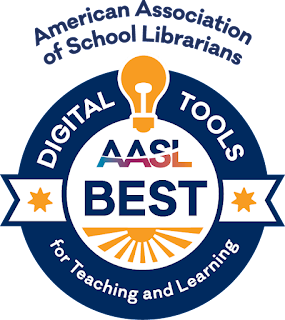Each year, the American Association of School Librarians highlights the “Best Digital Tools for Teaching & Learning,” which are recognized “for fostering qualities of Innovation/Creativity, Active Participation, Collaboration, User-Friendly, Encourages Exploration, and Information/Reference” (AASL, 2021). For my studies this week in LIS 5100, “Foundations of Librarianship,” I was tasked with describing one of these apps. I chose the “Diverse BookFinder.”
The Diverse BookFinder is a searchable database of children’s trade picture books, published since 2002, which feature Black and Indigenous and People of Color (BIPOC). The database also tracks how these characters appear, categorizing types of stories: “for instance, how many characters of each group are featured in books about struggle (Oppression), about cultural particularity (Beautiful Life), or that do no[t] make race or culture central to the story (Any Child)” (Diverse BookFinder, n.d., b).
When searching the database, I was also able to access books in which characters have intersecting identities, such as gender expression and disability. I searched with both a SmartPhone and a desktop computer, and found the database responsive to these very different screen formats.
The books in Diverse BookFinder are part of the library collection at Bates College in Lewiston, Maine, and are available for borrowing through Interlibrary loan (Diverse BookFinder, n.d., c).
Diverse BookFinder makes an important distinction about the books in its collection, which is that it “is not a list of recommended titles. While we highlight books by trending topics, it is our intention to collect every book published or reprinted since 2002, not just the ‘good’ ones.
“In this way, we’re able to provide data-driven insight and add to the broader discussion about diversity in children’s literature in a way never done before. So, not only do we highlight books by trending topic, but perhaps more meaningfully, we can highlight trends within the broader world of multicultural picture books” (n.d., b).
Diverse BookFinder also offers a free Collection Analysis Tool (CAT) to help libraries and classrooms diversify their picture book collections: “You upload a file containing ISBNs and titles for your picture book collection (including nonfiction). We cross-reference this file with the Diverse BookFinder collection to identify your multicultural picture books. We then provide a report of who (which racial/cultural groups) is represented and how (what themes predominate for each group) within this subset of your collection. This approach reveals the strengths and gaps in the racial/cultural representation within your collection. You can then use the Diverse BookFinder Search Tool to identify books to add to your collection that enrich your picture book holdings” (Diverse BookFinder, n.d., a).
I envision adults as primary users of both the database and the CAT, but students may also enjoy using the database to learn about books that “mirror” their experiences or offer a “window” into other people’s lives.
(In using these terms, I wish to credit Dr. Rudine Sims Bishop, whose original article in 1990 launched a metaphor so widely used today, that “Books are sometimes windows, offering views of worlds that may be real or imagined, familiar or strange. These windows are also sliding glass doors, and readers have only to walk through in imagination to become part of whatever world has been created by the author. When lighting conditions are just right, however, a window can also be a mirror. Literature transforms human experience and reflects it back to us, and in that reflection we can see our own lives and experiences as part of the larger human experience” ([Bishop, 1990/2015, p. 1]).
Both the database and the CAT would be of benefit to teachers and librarians, who strive for greater diversity among the books in their classroom or library. My caveat for student use is that students may become frustrated if they cannot obtain a book, since the database doesn’t reflect their home library catalog, but rather the collection at Bates.
References:
American Association of School Librarians. (2021). Best digital tools for teaching & learning. https://www.ala.org/aasl/awards/best
Bishop, R.S. (2015). Mirrors, windows, and sliding glass doors. Reading is Fundamental, Jan. 3, 2015. https://scenicregional.org/wp-content/uploads/2017/08/Mirrors-Windows-and-Sliding-Glass-Doors.pdf (Reprinted from “Mirrors, windows, and sliding glass doors,” 1990, Perspectives: Choosing and Using Books for the Classroom, 6 [3])
Diverse BookFinder. (n.d., a) Collection analysis tool (CAT): FAQ/Help. https://cat.diversebookfinder.org/help
Diverse BookFinder. (n.d., b) First time here? Welcome to the Diverse BookFinder. https://diversebookfinder.org/first-time-here-welcome-to-diverse-bookfinder/
Diverse BookFinder. (n.d., c) Our collection. https://diversebookfinder.org/our-collection/
Subscribe to:
Post Comments (Atom)
Subject Classifications (Partial list, via Dewey Decimal System)
- 006.754-Social Media
- 020-Library and Information Science
- 020.7025-Library Education
- 020.92-Cynthia M. Parkhill (Biographical)
- 023.3-Library Workers
- 025.00285-Digital libraries
- 025.04-Internet Access
- 025.2-Libraries--Collection Development
- 025.213-Libraries--Censorship
- 025.3-Libraries--Cataloging
- 025.84-Books--Conservation and restoration
- 027.473-Public Libraries--Sonoma County CA
- 027.663-Libraries and people with disabilities
- 027.7-Academic Libraries--University of Central Missouri
- 027.8-School Libraries--Santa Rosa Charter School for the Arts
- 028.52-Children's Literature
- 028.535-Young Adult Literature
- 028.7-Information Literacy
- 158.2-Social Intelligence
- 302.34-Bullying
- 305.9085-Autism (People with Developmental Disabilities)
- 306.76-Sexual orientation and gender identity
- 371-Schools--Santa Rosa Charter School for the Arts
- 371-Schools--Santa Rosa City Schools
- 636.8-Cats
- 646.2-Sewing
- 658.812-Customer Service
- 659.2-Public Relations
- 686.22-Graphic Design
- 700-The Arts
- 746.43-Yarn bombing (Knitting and Crochet)
- 808.51-Public Speaking
- 809-Book Reviews

No comments:
Post a Comment
Robust debate and even unusual opinions are encouraged, but please stay on-topic and be respectful. Comments are subject to review for personal attacks or insults, discriminatory statements, hyperlinks not directly related to the discussion and commercial spam.